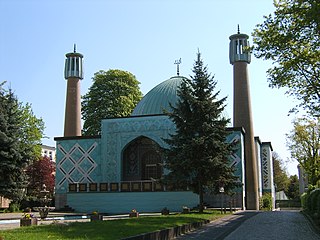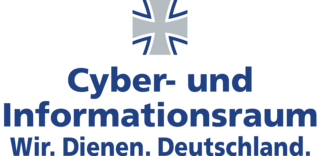
Technische Universität Berlin is a public research university located in Berlin, Germany. It was the first German university to adopt the name "Technische Universität".
The Fraunhofer Society is a German publicly-owned research organization with 76 institutes spread throughout Germany, each focusing on different fields of applied science. With some 30,800 employees, mainly scientists and engineers, and with an annual research budget of about €3.0 billion, it is the biggest organization for applied research and development services in Europe. It is named after Joseph von Fraunhofer who, as a scientist, an engineer, and an entrepreneur, is said to have superbly exemplified the goals of the society.

ETH Zurich is a public research university in Zurich, Switzerland. Founded in 1854 with the stated mission to educate engineers and scientists, the university focuses primarily on science, technology, engineering, and mathematics.

The Islamic Centre Hamburg, also known as the Blue Mosque, was the oldest mosque in Hamburg, Germany, being established in the late 1950s by a group of Iranian emigrants and business people and built in the early 1960s. Amid investigations regarding its ties with Iran and Hezbollah, the IZH was judged unconstitutional and closed by the German government in July 2024.

The Northern Institute of Technology Management (NIT) is an educational institute located in Hamburg. The institute was founded in 1998 by 40 professors of the Hamburg University of Technology TUHH. The first president of the NIT was the renowned scientist and former president of the TUHH, Hauke Trinks. The institute was originally founded with the name „Northern Institute of Technology“, which was extended with the addition of „Management“ in December 2007.
The Hamburg University of Technology is a research university in Germany. The university was founded in 1978 and in 1982/83 lecturing followed. Around 110 senior lecturers/professors and 1,410 members of staff work at the TUHH.

The Gottfried Wilhelm Leibniz Prize, or Leibniz Prize, is awarded by the German Research Foundation to "exceptional scientists and academics for their outstanding achievements in the field of research". Since 1986, up to ten prizes have been awarded annually to individuals or research groups working at a research institution in Germany or at a German research institution abroad. It is considered the most important research award in Germany.

The Karlsruhe Institute of Technology is both a German public research university in Karlsruhe, Baden-Württemberg, and a research center of the Helmholtz Association.

Berthold Leibinger was a German mechanical engineer, businessman, and philanthropist. He was the head of the German company Trumpf, a leader in laser technology, and founder of the non-profit foundation Berthold Leibinger Stiftung. He served on the advisory board of major companies and was awarded an honorary doctorate by the University of Stuttgart.
The European Inventor Award, are presented annually by the European Patent Office, sometimes supported by the respective Presidency of the Council of the European Union and by the European Commission, to inventors who have made a significant contribution to innovation, economy and society, predominantly in Europe. Inventions from all technological fields are considered for this award. The winners in each category are presented with an award shaped like a sail. There is no cash prize associated with the award, however there is a cash prize for all 3 of the Young Inventors Prize finalists.

Trumpf SE + Co. KG is a German family-owned company based in Ditzingen near Stuttgart, Baden-Württemberg. It originates from Julius Geiger's mechanical workshop. The Trumpf and Leibinger families transformed the medium-sized company into a globally recognized industrial group. Today, the company is one of the world’s largest suppliers of machine tools and a leader in laser technology. Trumpf is one of the most well-known representatives of the German 'Mittelstand.'
Hamburg Aviation, formerly the "Luftfahrtcluster Metropolregion Hamburg e.V." is an association of aviation organizations in Hamburg, Germany. Its goal is to promote the aviation industry in the Hamburg Metropolitan Region.

Christian M. Ringle is a professor of management and decision sciences at the Hamburg University of Technology, Germany. He is managing director of SmartPLS, a partial least squares path modeling method. Since 2018 he has been included in a list of highly cited researchers compiled by Clarivate Analytics.
The Hamburg Centre for Ultrafast Imaging (CUI) is a research facility established in the context of the Universities Excellence Initiative by the German Federal and State Governments. The multidisciplinary and interinstitutional cluster is located at Universität Hamburg, Hamburg, Germany, and has been initiated on 1 November 2012. The funding with more than €25 million by the German Research Foundation will run until 31. December 2018. Scientific teams cooperating in the cluster come from the Universität Hamburg, the Deutsches Elektronen-Synchrotron (DESY), the European XFEL GmbH (XFEL), the European Molecular Biology Laboratory (EMBL), and the newly founded Max-Planck-Institute for the Structure and Dynamics of Matter (MPSD). A full application for a second research period of seven years was handed in at the end of 2017 to the German Research Foundation (DFG) for discussion. After the successful application in 2018, the new cluster “CUI: Advanced Imaging of Matter” started in 2019.
Frank Mücklich is a German materials scientist. He is professor at Saarland University and leads the Chair of Functional Materials.

The Cyber and Information Domain Service is the youngest branch of the German Armed Forces, the Bundeswehr. The decision to form an organizational unit was presented by Defense Minister Ursula von der Leyen on 26 April 2016, becoming operational on 1 April 2017. It is headquartered in Bonn.

Ursula Keller is a Swiss physicist. She has been a tenured physics professor at the ETH Zurich, Switzerland since 1993. A pioneer in ultrafast science and technology, she is known for inventing the semiconductor saturable absorber mirror (SESAM), enabling passive mode-locking of lasers and revolutionizing ultrafast laser applications in science and industry. Keller led the Swiss NCCR MUST program in ultrafast science (2010–2022), co-founded several companies, including Time-Bandwidth Products and K2 Photonics, and published a graduate textbook "Ultrafast Laser Physics" with Springer Verlag. She is highly cited and received many prestigious awards. From 2012-2016 she was the founding president of the Women Professors Forum at ETH Zurich.

Bernhard Wilhelm Roth is a German experimental physicist.
In materials science, Direct Laser Interference Patterning (DLIP) is a laser-based technology that uses the physical principle of interference of high-intensity, coherent laser pulses to produce functional periodic microstructures. To achieve interference, the beam is divided by a beam splitter, specialized prisms, or other elements. The beams are then overlapped on amaterial surface to form an interference pattern. If the power of the laser beam is sufficiently high, material removal can occur at the interference maxima through processes such as remelting, evaporation and ablation, while the material at the interference minima remains mostly intact. In this way, a large variety of periodic patterns can be created on the surface of the material. Depending on the lasers used, DLIP can be applied to almost any material and can change the properties of surfaces in many technological areas with regard to electrical and optical properties, tribology (friction and wear), light absorption and wettability.

Jürgen W. Czarske is a German electrical engineer and a measurement system technician. He is the director of the TU Dresden Biomedical Computational Laser Systems competence center and a co-opted professor of physics.













